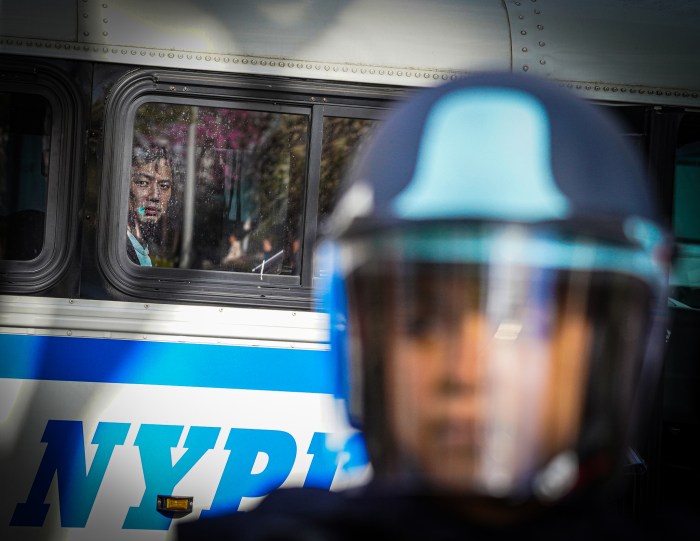“This used…
By Patricia Demchak
Neighbors complain that St. John’s University’s growing resident community is forcing them to endure a nighttime environment straight out of “Animal House,” the classic college party movie featuring rowdy crowds, lewd humor and rude behavior.
“This used to be a nice, quiet neighborhood,” said Maryanne Tom, who has lived at 172-18 82nd Ave. since 1996. Like others in the Hillcrest Estates community, she said she has been disturbed at night by loud revelry, has witnessed fights and students urinating in the streets and sometimes finds trash or beer cans discarded on her lawn.
Students say neighbors are overreacting to the misbehavior of a few unruly students, and a spokesman for the university said St. John’s is trying to resolve an important but not overly serious problem.
Even before St. John’s provided on-campus housing, the surrounding community used to complain about loud students partying in several nearby bars along Union Turnpike. Only one of the bars remains open today.
“I don’t think it has anything to do with the resident students here,” said sophomore Robert Cotto, who lives in Hillcrest Hall on campus. “There are a few bad apples that spoil the bunch, but generally it’s very quiet here at night.”
Second-semester student Derek Smith agreed. After 10 p.m., “there’s only about a dozen people out. I wouldn’t really perceive it to be rowdy at all,” Smith said. He added, “I’ve seen many college campuses, and this is probably the lowest key I’ve seen.”
St. John’s, the nation’s largest Catholic university, had been a commuter college exclusively until 1999 when the first dormitories opened.
Both St. John’s students and university spokesman Jody Fisher say the majority of students are quiet and well-behaved.
Fisher also said the university is working to find a solution that satisfies the community without compromising the safety of students.
Nevertheless, neighbors contend St. John’s is not doing enough.
Last week Kevin Forrestal, president of the Hillcrest Estates Civic Association, sent a letter to the school and Queens newspapers demanding a series of changes. His demands include posting evening security guards and closing two entrance gates to nighttime pedestrian traffic.
The controversy centers primarily around Gate 7, the campus entrance closest both to the school’s five-dorm residence village and the Hillcrest Estates homes sandwiched between the roar of the Grand Central Parkway and the southern boundary of St. John’s on 82nd Avenue.
The gate, at 172nd Street and 82nd Avenue, was open to cars and pedestrians until residents’ complaints spurred the university to close it to vehicles Jan. 18.
Forrestal said conditions have unexpectedly worsened since then, as students continue to park off-campus and use Gate 7 as their prime all-hours access point. Residents like Tom say they want the gate closed completely.
“If they didn’t have access to this gate at all, then they would have no reason to come through here and we wouldn’t be hearing them at all,” Tom said.
Fisher said the gate will be closed once the university completes plans to build a parking garage on the Grand Central service road near the dorms. Although plans have yet to be approved, Fisher estimated the garage should be built within 16 months.
In the meantime, Gate 7 will remain open so students don’t have to trek across a dark campus at night, a safety measure recommended last year by Police Commissioner Ray Kelly in a security review for the school after the shooting of a student football player near the dorms, Fisher said.
Forrestal also called for increased campus security at night. A guard is now posted at Gate 7 from 11:30 p.m. to 6 a.m., Fisher said.
But the true source of tension is the residence village itself: Forrestal and others believe the halls should never have been built so nearby.
“The closer you put the students to the street and somebody’s house, obviously the more problems you are going to have,” Forrestal said.
“The dorms should not exist in the first place,” Tom said. “We opposed it so much, but it’s like fighting a giant.”
Fisher said St. John’s had little choice but to build dormitories. Although St. John’s was a commuter university for 129 years, its growing national reputation has long drawn students from outside the New York area — students who needed a place to live, Fisher said. In order to attract and keep such students, the board of trustees decided to create the residence village.
The first three dorms opened in 1999, followed by two more in 2000, bringing capacity to about 1,800 students, Fisher said. A sixth hall is under construction. When completed, the village could house as many as 2,200 students, he said.
Since plans for the dorms first began, the school has held meetings with the community and has encountered opposition, Fisher said. While the school has agreed to some compromises, like limiting dorms’ height, Fisher said it cannot “turn things upside down” to satisfy every concern of the community.
Reach reporter Patricia Demchak at timesledger@aol.com or call 229-0300, Ext. 155






























